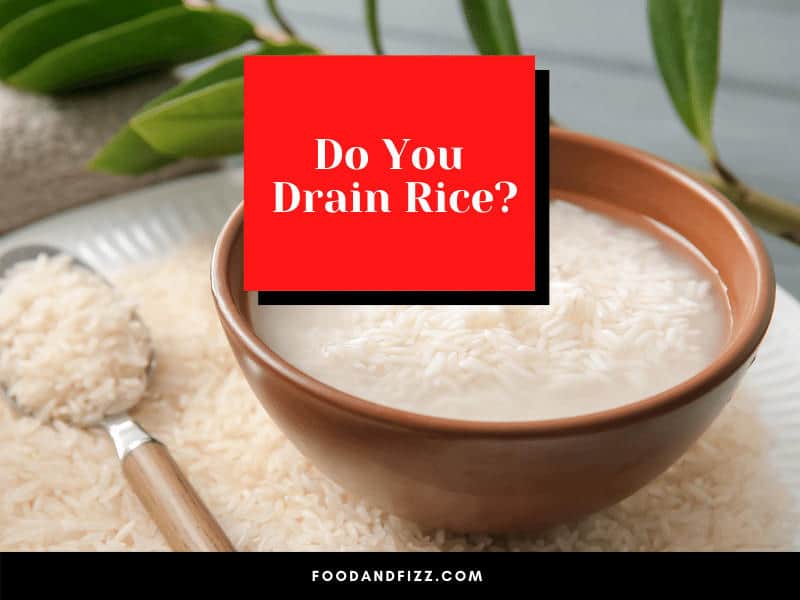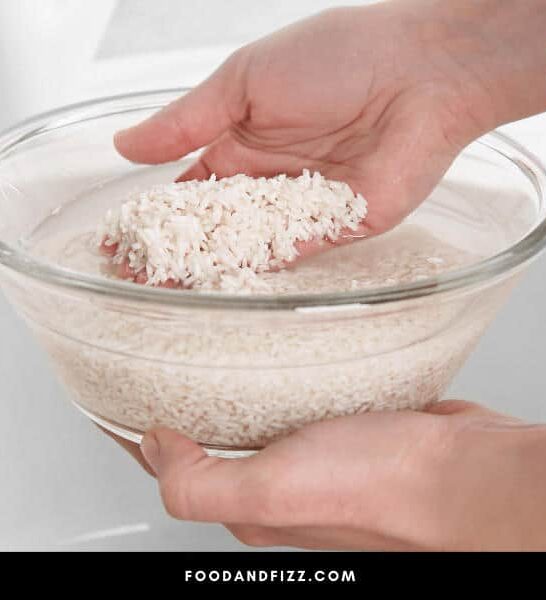Rice is amazing and versatile. It can be the star of a dish, a complement to other flavors, or a side dish. There are over 120,000 types of rice worldwide according to Think Rice, but only a few ways to cook them.
Do You Drain Your Rice?
If you drain your rice depends on how you are cooking your rice. If you cook rice by adding a copious amount of water, yes you’ll need to drain it. If you rinse or soak your rice, you’ll need to drain it. If you use the absorption method, you won’t need to drain your rice.

Rice Cooking Methods
There are three main methods of cooking rice.
The first method is to add plenty of water, and drain the excess water after the rice is finished cooking.
If you use the absorption method, you’ll only add the amount of water the rice needs to cook, so you won’t need to drain it.
Lastly, you can steam the rice. This method doesn’t require draining either.
You’ll also need to drain the rice if you rinse or soak it.

Absorption Method
One way of cooking rice is the absorption method. This method requires precision. You’ll need to add the correct amount of water for the rice to absorb.
If you add too much, the rice will be too soft. If you don’t add enough water, the rice is undercooked. The rice can also burn if there’s not enough water.
Generally, you’ll need twice as much water as rice for this method. However, different types of rice can require different amounts of water.
The package directions are a good way to determine how much water you need for the amount of rice you are using.
The rule for this method is to cover the pot with a tight-fitting lid. Most recipes call for bringing the rice to a boil on high heat, and then reducing the heat to low.
The lid keeps the steam from escaping. The rice continues to cook after the heat is turned off. Just keep the lid on to keep the steam and heat in. Leave the rice covered for 10-20 minutes.
The Boiling Method
If you don’t know how much water you need, or don’t want to bother with measuring the rice and water, you can use the boiling method. Simply add more water than the rice needs. Once it’s cooked, you’ll use a colander to drain the remaining water.
Parboiling
This method is the same as boiling, only you don’t cook it completely. For this method, you only partially cook the rice. Once it’s finished cooking, you drain the rice.
This method is used for dishes like Briyani, when the rice is cooked further as a part of another dish. You only partially cook the rice because you want the rice to absorb the flavors of the dish.

Steaming Rice
Steaming is another way to cook rice. Some types of rice actually require being steamed. This is required for sushi or sticky rice. Generally, short grained rices do well with steaming, and long grained rices are better for boiling with the methods above.
To steam rice the traditional way, you’ll need a steamer pot and basket. The water goes into the pot. Then, you place the rice in the basket. The basket goes onto the pot. Cover the basket with a lid, to prevent the steam from escaping.
The water should be below the basket. If the water reaches the basket, then you are technically boiling the rice, not steaming it.

Which is Better, Parboiling or Absorption Method?
Neither method of cooking rice is right or wrong. Which is better for you depends on a few factors.
First, parboiling is more forgiving. If you use the absorption method, you’ll need to get the amount of water correct. Parboiling allows you to simply dump a copious amount of water into the pot.
Secondly, it depends on how you want the rice to turn out. Steaming will make the rice sticky and soft. This is excellent for use in sushi, or in situations where you want to mold the rice.
The absorption method makes the rice fluffy and firm. The boiling method results in firmer grains. It’s great for using as a side dish.
Should You Rinse Rice?
If you rinse or soak your rice, you’ll need to drain it before cooking. Rinsing rice used to be required. In times past, rice contained a lot of dust and starch. There may also be debris in the rice.
So, the rice needed to be rinsed before cooking. Some types of rice, like sweet or sticky rice, require lots of rinsing. You’ll need to continue rinsing until the water stops turning white.
However, most types of rice today don’t require rinsing before cooking.
If you do rinse your rice, you should drain it before cooking, regardless of what cooking method you choose to use.

Should You Soak Rice?
Whether or not you should soak your rice also depends on the type of rice. Glutinous, wild, or whole grain rice require soaking, in some cases, overnight. Most white rice doesn’t require soaking.
If you do soak the rice, the amount of water required during cooking will be reduced. Soaking allows the rice to soak up water before cooking. This means it will not absorb as much rice during the cooking process.
Conclusion to Do you Drain Rice?
There are some situations when you will need to drain rice. If you are parboiling, then you’ll need to drain it after cooking. If you rinse or soak the rice, you will need to drain it before cooking.
If you use the absorption method, there’s no need to drain your rice.
Frequently Asked Questions on Do You Drain Rice?
Why Does Rice Become Mushy?
If your rice is mushy, it’s because it’s overcooked. This generally means that the rice has been cooked too long. This causes it to absorb too much water.
How Do You Fluff Rice?
After your rice has cooked, allow it to sit covered for at least 10 minutes. Then fluff it with a fork or rice paddle. Do not stir the rice, simply lift the rice with the fork.
Should Rice Be Rinsed After Cooking?
No, you should never rinse your rice after cooking. This will make it mushy or sticky. Drain it if needed, but don’t rinse it.

